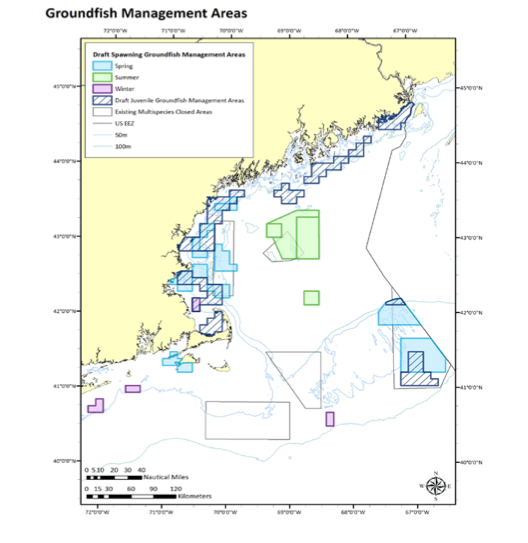April 26, 2013 — The following was released today by the New England Fishery Management Council:
The conservation of marine habitats is an important topic in the context of fisheries management although the development of rules to effectively address the issue can be a daunting task. It is no less so in New England where the federal fishery council is considering ways to protect juvenile and spawning groundfish areas.
At its three-day meeting in Mystic, CT this week, the New England Fishery Council received the first report from its Closed Area Technical Team (or CATT). Since January, the group of fisheries experts has been responding to a Council request to examine area management options that could enhance groundfish fishery productivity. In tasking the team, the Council provided the following objectives:
1) Improve spawning protection;
2) Improve protection of critical groundfish habitats;
3) Improve refuge for critical life history stages; and
4) Improve access to both use and non-use benefits arising from closed area management across gear types, fisheries and groups.
The CATT’s work included multiple, specific options that would protect areas with aggregations of juvenile groundfish — for example, young cod up to 10 inches in spring and summer and up to 14 inches in the fall and winter — by limiting fishing gears that have adverse habitat impacts. Further, seasonal “hot spots” of spawning-sized groundfish, older and larger animals, were used to identify times and places during which fishing could have a negative effect on spawning activity .
On Wednesday, the Council provided additional guidance to the CATT by asking them to emphasize options that focus on the region’s two cod stocks, Georges Bank yellowtail flounder, the two haddock stocks, halibut, ocean pout, Southern New England winter flounder and wolffish.
Given that efforts by the Council’s Habitat Committee and Habitat Plan Development Team have also been underway to look at the adverse effects of fishing on vulnerable bottom substrates and habitats, next steps were discussed to integrate that work, including a number of proposed area closures, with the CATT’s options.
And as discussed and approved by Council members at the meeting, the Habitat Committee was directed to include a “no ground cable” option for trawl gear as an alternative to closures for habitat management areas on Georges Bank; and to include in that option a mechanism to allow a framework adjustment to change the restriction to a modified ground cable rule.
Once the Habitat Committee and CATT proposals have been finalized, the next step will involve modifying the proposals to meet both habitat and groundfish objectives. Work will be accomplished at joint meetings of the Habitat and Groundfish Committees and will addressfurther adjustments, area overlaps, the relation between the current proposed areas and the existing rolling closures that now seasonally restrict groundfish fishing.
The joint meetings are scheduled for May 17 in Portsmouth, NH and June 11 in Providence, RI. The end product will ultimately become an action that amends all New England Council Fishery Management Plans in Habitat Omnibus Amendment 2.
The map below depicts the Closed Area Technical Team’s identification of areas to protect juvenile and spawning groundfish. These areas as well as the Habitat Committee’s proposals will be revised prior to the June 2013 Council meeting in Portland, ME.

For more information:
Read a PDF of the press release
Visit the New England Fishey Management Council's website
Read the complete CATT presentation
